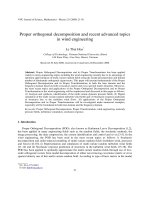advanced topics in java core concepts in data structures
Bạn đang xem bản rút gọn của tài liệu. Xem và tải ngay bản đầy đủ của tài liệu tại đây (7.28 MB, 322 trang )
Kalicharan
Shelve in
Programming Languages/Java
User level:
Intermediate
www.apress.com
SOURCE CODE ONLINE
BOOKS FOR PROFESSIONALS BY PROFESSIONALS
®
Advanced Topics in Java
RELATED
Over the years, Java’s popularity has grown to the point where it plays an important
role in most of our lives. From laptops to data centers, game consoles to scientific
supercomputers, cell phones to the Internet, Java is everywhere! There are tons of
applications and heaps of websites that will not work unless you have Java installed,
and more are created every day. And, of course, Java is used to power what has
become the world’s most dominant mobile platform, Android.
Advanced Topics In Java teaches the algorithms and concepts that any budding
software developer should know. You’ll delve into topics such as sorting, searching,
merging, recursion, random numbers and simulation, among others. You will increase
the range of problems you can solve when you learn how to create and manipulate
versatile and popular data structures such as binary trees and hash tables.
This book assumes you have a working knowledge of basic programming
concepts such as variables, constants, assignment, selection (if else) and looping
(while, for). It also assumes you are comfortable with writing functions and working
with arrays. If you study this book carefully and do the exercises conscientiously,
you would become a better and more agile software developer, more prepared to
code today’s applications - no matter the language.
What You’ll Learn:
• How to use some advanced algorithms, implemented in Java
• How to create, manipulate and use linked lists, stacks and queues
• How to use random numbers to program games and simulations
• How to work with files, binary trees and hash tables
• Sophisticated sorting methods such as heapsort, quicksort and mergesort
• How to implement all of the above in Java
9 781430 266198
54999
ISBN 978-1-4302-6619-8
For your convenience Apress has placed some of the front
matter material after the index. Please use the Bookmarks
and Contents at a Glance links to access them.
v
Contents at a Glance
About the Author ���������������������������������������������������������������������������������������������������������������xiii
About the Technical Reviewers ������������������������������������������������������������������������������������������ xv
Preface ����������������������������������������������������������������������������������������������������������������������������� xvii
Chapter 1: Sorting, Searching, and Merging ■ ���������������������������������������������������������������������1
Chapter 2: Introduction to Objects ■ ����������������������������������������������������������������������������������29
Chapter 3: Linked Lists ■ ����������������������������������������������������������������������������������������������������71
Chapter 4: Stacks and Queues ■ ���������������������������������������������������������������������������������������111
Chapter 5: Recursion ■ �����������������������������������������������������������������������������������������������������143
Chapter 6: Random Numbers, Games, and Simulation ■ ��������������������������������������������������167
Chapter 7: Working with Files ■ ���������������������������������������������������������������������������������������189
Chapter 8: Introduction to Binary Trees ■ ������������������������������������������������������������������������219
Chapter 9: Advanced Sorting ■ �����������������������������������������������������������������������������������������259
Chapter 10: Hashing ■ ������������������������������������������������������������������������������������������������������287
Index ���������������������������������������������������������������������������������������������������������������������������������309
1
Chapter 1
Sorting, Searching, and Merging
In this chapter, we will explain the following:
How to sort a list of items using selection sort•
How to sort a list of items using insertion sort•
How to add a new item to a sorted list so that the list remains sorted•
How to sort an array of strings•
How to sort related (parallel) arrays•
How to search a sorted list using binary search•
How to search an array of strings•
How to write a program to do a frequency count of words in a passage•
How to merge two sorted lists to create one sorted list•
1.1 Sorting an Array: Selection Sort
Sorting is the process by which a set of values are arranged in ascending or descending order. There are many reasons
to sort. Sometimes we sort in order to produce more readable output (for example, to produce an alphabetical listing).
A teacher may need to sort her students in order by name or by average score. If we have a large set of values and we
want to identify duplicates, we can do so by sorting; the repeated values will come together in the sorted list.
Another advantage of sorting is that some operations can be performed faster and more efficiently with sorted
data. For example, if data is sorted, it is possible to search it using binary search—this is much faster than using a
sequential search. Also, merging two separate lists of items can be done much faster than if the lists were unsorted.
There are many ways to sort. In this chapter, we will discuss two of the “simple” methods: selection and insertion
sort. In Chapter 9, we will look at more sophisticated ways to sort. We start with selection sort.
Consider the following list of numbers stored in a Java array, num:
CHAPTER 1 ■ SORTING, SEARCHING, AND MERGING
2
Sorting num in ascending order using selection sort proceeds as follows:
1
st
pass
Find the smallest number in the entire list, from positions • 0 to 6; the smallest is 15,
found in position 4.
Interchange the numbers in positions • 0 and 4. This gives us the following:
3
rd
pass
Find the smallest number in positions • 2 to 6; the smallest is 48, found in position 5.
Interchange the numbers in positions • 2 and 5. This gives us the following:
4
th
pass
Find the smallest number in positions • 3 to 6; the smallest is 52, found in position 6.
Interchange the numbers in positions • 3 and 6. This gives us the following:
5
th
pass
Find the smallest number in positions • 4 to 6; the smallest is 57, found in position 4.
Interchange the numbers in positions • 4 and 4. This gives us the following:
2
nd
pass
Find the smallest number in positions • 1 to 6; the smallest is 33, found in position 5.
Interchange the numbers in positions • 1 and 5. This gives us the following:
CHAPTER 1 ■ SORTING, SEARCHING, AND MERGING
3
6
th
pass
Find the smallest number in positions • 5 to 6; the smallest is 65, found in position 6.
Interchange the numbers in positions • 5 and 6. This gives us the following:
The array is now completely sorted. Note that once the 6
th
largest (65) has been placed in its final position (5),
the largest (79) would automatically be in the last position (6).
In this example, we made six passes. We will count these passes by letting the variable h go from 0 to 5. On each
pass, we find the smallest number from positions h to 6. If the smallest number is in position s, we interchange the
numbers in positions h and s.
In general, for an array of size n, we make n-1 passes. In our example, we sorted 7 numbers in 6 passes.
The following is a pseudocode outline of the algorithm for sorting num[0 n-1]:
for h = 0 to n - 2
s = position of smallest number from num[h] to num[n-1]
swap num[h] and num[s]
endfor
We can implement this algorithm as follows, using the generic parameter list:
public static void selectionSort(int[] list, int lo, int hi) {
//sort list[lo] to list[hi] in ascending order
for (int h = lo; h < hi; h++) {
int s = getSmallest(list, h, hi);
swap(list, h, s);
}
}
The two statements in the for loop could be replaced by the following:
swap(list, h, getSmallest(list, h, hi));
We can write getSmallest and swap as follows:
public static int getSmallest(int list[], int lo, int hi) {
//return location of smallest from list[lo hi]
int small = lo;
for (int h = lo + 1; h <= hi; h++)
if (list[h] < list[small]) small = h;
return small;
}
public static void swap(int list[], int i, int j) {
//swap elements list[i] and list[j]
int hold = list[i];
list[i] = list[j];
list[j] = hold;
}
CHAPTER 1 ■ SORTING, SEARCHING, AND MERGING
4
To test whether selectionSort works properly, we write Program P1.1. Only main is shown. To complete the
program, just add selectionSort, getSmallest, and swap.
Program P1.1
import java.util.*;
public class SelectSortTest {
final static int MaxNumbers = 10;
public static void main(String[] args) {
Scanner in = new Scanner(System.in);
int[] num = new int[MaxNumbers];
System.out.printf("Type up to %d numbers followed by 0\n", MaxNumbers);
int n = 0;
int v = in.nextInt();
while (v != 0 && n < MaxNumbers) {
num[n++] = v;
v = in.nextInt();
}
if (v != 0) {
System.out.printf("\nMore than %d numbers entered\n", MaxNumbers);
System.out.printf("First %d used\n", MaxNumbers);
}
if (n == 0) {
System.out.printf("\nNo numbers supplied\n");
System.exit(1);
}
//n numbers are stored from num[0] to num[n-1]
selectionSort(num, 0, n-1);
System.out.printf("\nThe sorted numbers are\n");
for (v = 0; v < n; v++) System.out.printf("%d ", num[v]);
System.out.printf("\n");
} //end main
// selectionSort, getSmallest and swap go here
} //end class SelectSortTest
The program requests up to 10 numbers (as defined by MaxNumbers), stores them in the array num, calls
selectionSort, and then prints the sorted list.
The following is a sample run of the program:
Type up to 10 numbers followed by 0
57 48 79 65 15 33 52 0
The sorted numbers are
15 33 48 52 57 65 79
Note that if the user enters more than ten numbers, the program will recognize this and sort only the first ten.
CHAPTER 1 ■ SORTING, SEARCHING, AND MERGING
5
1.1.1 Analysis of Selection Sort
To find the smallest of k items, we make k-1 comparisons. On the first pass, we make n-1 comparisons to find the
smallest of n items. On the second pass, we make n-2 comparisons to find the smallest of n-1 items. And so on, until
the last pass where we make one comparison to find the smaller of two items. In general, on the jth pass, we make n-j
comparisons to find the smallest of n-j+1 items. Hence, we have this:
total number of comparisons = 1 + 2 + …+ n-1 = ½ n(n-1) » ½ n
2
We say selection sort is of order O(n
2
) (“big O n squared”). The constant ½ is not important in “big O” notation
since, as n gets very big, the constant becomes insignificant.
On each pass, we swap two items using three assignments. Since we make n-1 passes, we make 3(n-1)
assignments in all. Using “big O” notation, we say that the number of assignments is O(n). The constants 3 and 1 are
not important as n gets large.
Does selection sort perform any better if there is order in the data? No. One way to find out is to give it a sorted list
and see what it does. If you work through the algorithm, you will see that the method is oblivious to order in the data.
It will make the same number of comparisons every time, regardless of the data.
As we will see, some sorting methods (mergesort and quicksort; see Chapters 5 and 9) require extra array storage to
implement them. Note that selection sort is performed “in place” in the given array and does not require additional storage.
As an exercise, modify the programming code so that it counts the number of comparisons and assignments
made in sorting a list using selection sort.
1.2 Sorting an Array: Insertion Sort
Consider the same array as before:
Now, think of the numbers as cards on a table that are picked up one at a time in the order they appear in the
array. Thus, we first pick up 57, then 48, then 79, and so on, until we pick up 52. However, as we pick up each new
number, we add it to our hand in such a way that the numbers in our hand are all sorted.
When we pick up 57, we have just one number in our hand. We consider one number to be sorted.
When we pick up 48, we add it in front of 57 so our hand contains the following:
48 57
When we pick up 79, we place it after 57 so our hand contains this:
48 57 79
When we pick up 65, we place it after 57 so our hand contains this:
48 57 65 79
At this stage, four numbers have been picked up, and our hand contains them in sorted order.
When we pick up 15, we place it before 48 so our hand contains this:
15 48 57 65 79
When we pick up 33, we place it after 15 so our hand contains this:
15 33 48 57 65 79
Finally, when we pick up 52, we place it after 48 so our hand contains this:
15 33 48 52 57 65 79
CHAPTER 1 ■ SORTING, SEARCHING, AND MERGING
6
The numbers have been sorted in ascending order.
The method described illustrates the idea behind insertion sort. The numbers in the array will be processed one
at a time, from left to right. This is equivalent to picking up the numbers from the table one at a time. Since the first
number, by itself, is sorted, we will process the numbers in the array starting from the second.
When we come to process num[h], we can assume that num[0] to num[h-1] are sorted. We insert num[h] among
num[0] to num[h-1] so that num[0] to num[h] are sorted. We then go on to process num[h+1]. When we do so, our
assumption that num[0] to num[h] are sorted will be true.
Sorting num in ascending order using insertion sort proceeds as follows:
1
st
pass
Process • num[1], that is, 48. This involves placing 48 so that the first two numbers are sorted;
num[0] and num[1] now contain the following:
The rest of the array remains unchanged.
2
nd
pass
Process • num[2], that is, 79. This involves placing 79 so that the first three numbers are sorted;
num[0] to num[2] now contain the following:
The rest of the array remains unchanged.
3
rd
pass
Process • num[3], that is, 65. This involves placing 65 so that the first four numbers are sorted;
num[0] to num[3] now contain the following:
The rest of the array remains unchanged.
4
th
pass
Process • num[4], that is, 15. This involves placing 15 so that the first five numbers are sorted.
To simplify the explanation, think of 15 as being taken out and stored in a simple variable
(key, say) leaving a “hole” in num[4]. We can picture this as follows:
CHAPTER 1 ■ SORTING, SEARCHING, AND MERGING
7
The insertion of 15 in its correct position proceeds as follows:
Compare • 15 with 79; it is smaller, so move 79 to location 4, leaving location 3 free.
This gives the following:
Compare • 15 with 65; it is smaller, so move 65 to location 3, leaving location 2 free.
This gives the following:
Compare • 15 with 57; it is smaller, so move 57 to location 2, leaving location 1 free.
This gives the following:
Compare • 15 with 48; it is smaller, so move 48 to location 1, leaving location 0 free.
This gives the following:
There are no more numbers to compare with • 15, so it is inserted in location 0,
giving the following:
We can express the logic of placing • 15 (key) by comparing it with the numbers to its left,
starting with the nearest one. As long as key is less than num[k], for some k, we move num[k] to
position num[k + 1] and move on to consider num[k-1], providing it exists. It won’t exist when
k is actually 0. In this case, the process stops, and key is inserted in position 0.
5
th
pass
Process • num[5], that is, 33. This involves placing 33 so that the first six numbers are sorted.
This is done as follows:
Store • 33 in key, leaving location 5 free.
Compare • 33 with 79; it is smaller, so move 79 to location 5, leaving location 4 free.
Compare • 33 with 65; it is smaller, so move 65 to location 4, leaving location 3 free.
Compare • 33 with 57; it is smaller, so move 57 to location 3, leaving location 2 free.
Compare • 33 with 48; it is smaller, so move 48 to location 2, leaving location 1 free.
CHAPTER 1 ■ SORTING, SEARCHING, AND MERGING
8
We can express the logic of placing • 33 by comparing it with the numbers to its left, starting
with the nearest one. As long as key is less than num[k], for some k, we move num[k] to
position num[k + 1] and move on to consider num[k-1], providing it exists. If key is greater
than or equal to num[k] for some k, then key is inserted in position k+1. Here, 33 is greater
than num[0] and so is inserted into num[1].
6
th
pass
Process • num[6], that is, 52. This involves placing 52 so that the first seven (all) numbers are
sorted. This is done as follows:
Store • 52 in key, leaving location 6 free.
Compare • 52 with 79; it is smaller, so move 79 to location 6, leaving location 5 free.
Compare • 52 with 65; it is smaller, so move 65 to location 5, leaving location 4 free.
Compare • 52 with 57; it is smaller, so move 57 to location 4, leaving location 3 free.
Compare • 52 with 48; it is bigger; so insert 52 in location 3. This gives the following:
The array is now completely sorted.
The following is an outline of how to sort the first n elements of an array, num, using insertion sort:
for h = 1 to n - 1 do
insert num[h] among num[0] to num[h-1] so that num[0] to num[h] are sorted
endfor
Using this outline, we write the function insertionSort using the parameter list.
public static void insertionSort(int list[], int n) {
//sort list[0] to list[n-1] in ascending order
for (int h = 1; h < n; h++) {
int key = list[h];
int k = h - 1; //start comparing with previous item
while (k >= 0 && key < list[k]) {
list[k + 1] = list[k];
k;
}
list[k + 1] = key;
} //end for
} //end insertionSort
The while statement is at the heart of the sort. It states that as long as we are within the array (k >= 0) and
the current number (key) is less than the one in the array (key < list[k]), we move list[k] to the right
(list[k+1] = list[k]) and move on to the next number on the left ( k).
Compare • 33 with 15; it is bigger, so insert 33 in location 1. This gives the following:
CHAPTER 1 ■ SORTING, SEARCHING, AND MERGING
9
We exit the while loop if k is equal to -1 or if key is greater than or equal to list[k], for some k. In either case,
key is inserted into list[k+1].
If k is -1, it means that the current number is smaller than all the previous numbers in the list and must be
inserted in list[0]. But list[k + 1] is list[0] when k is -1, so key is inserted correctly in this case.
The function sorts in ascending order. To sort in descending order, all we have to do is change < to > in the while
condition, like this:
while (k >= 0 && key > list[k])
Now, a key moves to the left if it is bigger.
We write Program P1.2 to test whether insertionSort works correctly. Only main is shown. Adding the function
insertionSort completes the program.
Program P1.2
import java.util.*;
public class InsertSortTest {
final static int MaxNumbers = 10;
public static void main(String[] args) {
Scanner in = new Scanner(System.in);
int[] num = new int[MaxNumbers];
System.out.printf("Type up to %d numbers followed by 0\n", MaxNumbers);
int n = 0;
int v = in.nextInt();
while (v != 0 && n < MaxNumbers) {
num[n++] = v;
v = in.nextInt();
}
if (v != 0) {
System.out.printf("\nMore than %d numbers entered\n", MaxNumbers);
System.out.printf("First %d used\n", MaxNumbers);
}
if (n == 0) {
System.out.printf("\nNo numbers supplied\n");
System.exit(1);
}
//n numbers are stored from num[0] to num[n-1]
insertionSort(num, n);
System.out.printf("\nThe sorted numbers are\n");
for (v = 0; v < n; v++) System.out.printf("%d ", num[v]);
System.out.printf("\n");
} //end main
public static void insertionSort(int list[], int n) {
//sort list[0] to list[n-1] in ascending order
for (int h = 1; h < n; h++) {
int key = list[h];
int k = h - 1; //start comparing with previous item
while (k >= 0 && key < list[k]) {
list[k + 1] = list[k];
k;
}
CHAPTER 1 ■ SORTING, SEARCHING, AND MERGING
10
list[k + 1] = key;
} //end for
} //end insertionSort
} //end class InsertSortTest
The program requests up to ten numbers (as defined by MaxNumbers), stores them in the array num, calls
insertionSort, and then prints the sorted list.
The following is a sample run of the program:
Type up to 10 numbers followed by 0
57 48 79 65 15 33 52 0
The sorted numbers are
15 33 48 52 57 65 79
Note that if the user enters more than ten numbers, the program will recognize this and sort only the first ten.
We could easily generalize insertionSort to sort a portion of a list. To illustrate, we rewrite insertionSort
(calling it insertionSort1) to sort list[lo] to list[hi] where lo and hi are passed as arguments to the function.
Since element lo is the first one, we start processing elements from lo+1 until element hi. This is reflected in the
for statement. Also now, the lowest subscript is lo, rather than 0. This is reflected in the while condition k >= lo.
Everything else remains the same as before.
public static void insertionSort1(int list[], int lo, int hi) {
//sort list[lo] to list[hi] in ascending order
for (int h = lo + 1; h <= hi; h++) {
int key = list[h];
int k = h - 1; //start comparing with previous item
while (k >= lo && key < list[k]) {
list[k + 1] = list[k];
k;
}
list[k + 1] = key;
} //end for
} //end insertionSort1
We can test insertionSort1 with Program P1.2a.
Program P1.2a
import java.util.*;
public class InsertSort1Test {
final static int MaxNumbers = 10;
public static void main(String[] args) {
Scanner in = new Scanner(System.in);
int[] num = new int[MaxNumbers];
System.out.printf("Type up to %d numbers followed by 0\n", MaxNumbers);
int n = 0;
int v = in.nextInt();
while (v != 0 && n < MaxNumbers) {
num[n++] = v;
v = in.nextInt();
}
CHAPTER 1 ■ SORTING, SEARCHING, AND MERGING
11
if (v != 0) {
System.out.printf("\nMore than %d numbers entered\n", MaxNumbers);
System.out.printf("First %d used\n", MaxNumbers);
}
if (n == 0) {
System.out.printf("\nNo numbers supplied\n");
System.exit(1);
}
//n numbers are stored from num[0] to num[n-1]
insertionSort1(num, 0, n-1);
System.out.printf("\nThe sorted numbers are\n");
for (v = 0; v < n; v++) System.out.printf("%d ", num[v]);
System.out.printf("\n");
} //end main
// insertionSort1 goes here
} //end class InsertSort1Test
1.2.1 Analysis of Insertion Sort
In processing item j, we can make as few as 1 comparison (if num[j] is bigger than num[j-1]) or as many as j-1
comparisons (if num[j] is smaller than all the previous items). For random data, we would expect to make ½(j-1)
comparisons, on average. Hence, the average total number of comparisons to sort n items is:
{ } (
)
=
−= + + +− = − ≈
∑
n
2
1
( 1) ½ 1 2 1 ¼ 1 ¼
2
2
j
j n nn n
We say insertion sort is of order O(n
2
) (“big O n squared”). The constant ¼ is not important as n gets large.
Each time we make a comparison, we also make an assignment. Hence, the total number of assignments is also
¼ n(n-1) » ¼ n
2
.
We emphasize that this is an average for random data. Unlike selection sort, the actual performance of insertion
sort depends on the data supplied. If the given array is already sorted, insertion sort will quickly determine this by
making n-1 comparisons. In this case, it runs in O(n) time. One would expect that insertion sort will perform better
the more order there is in the data.
If the given data is in descending order, insertion sort performs at its worst since each new number has to travel
all the way to the beginning of the list. In this case, the number of comparisons is ½ n(n-1) » ½ n
2
. The number of
assignments is also ½ n(n-1) » ½ n
2
.
Thus, the number of comparisons made by insertion sort ranges from n-1 (best) to ¼ n
2
(average) to ½ n
2
(worst).
The number of assignments is always the same as the number of comparisons.
As with selection sort, insertion sort does not require extra array storage for its implementation.
As an exercise, modify the programming code so that it counts the number of comparisons and assignments
made in sorting a list using insertion sort.
CHAPTER 1 ■ SORTING, SEARCHING, AND MERGING
12
1.3 Inserting an Element in Place
Insertion sort uses the idea of adding a new element to an already sorted list so that the list remains sorted. We can
treat this as a problem in its own right (nothing to do with insertion sort). Specifically, given a sorted list of items from
list[m] to list[n], we want to add a new item (newItem, say) to the list so that list[m] to list[n+1] are sorted.
Adding a new item increases the size of the list by 1. We assume that the array has room to hold the new item.
We write the function insertInPlace to solve this problem.
public static void insertInPlace(int newItem, int list[], int m, int n) {
//list[m] to list[n] are sorted
//insert newItem so that list[m] to list[n+1] are sorted
int k = n;
while (k >= m && newItem < list[k]) {
list[k + 1] = list[k];
k;
}
list[k + 1] = newItem;
} //end insertInPlace
Using insertInPlace, we can rewrite insertionSort (calling it insertionSort2) as follows:
public static void insertionSort2(int list[], int lo, int hi) {
//sort list[lo] to list[hi] in ascending order
for (int h = lo + 1; h <= hi; h++)
insertInPlace(list[h], list, lo, h - 1);
} //end insertionSort2
We can test insertionSort2 with Program P1.2b.
Program P1.2b
import java.util.*;
public class InsertSort2Test {
final static int MaxNumbers = 10;
public static void main(String[] args) {
Scanner in = new Scanner(System.in);
int[] num = new int[MaxNumbers];
System.out.printf("Type up to %d numbers followed by 0\n", MaxNumbers);
int n = 0;
int v = in.nextInt();
while (v != 0 && n < MaxNumbers) {
num[n++] = v;
v = in.nextInt();
}
if (v != 0) {
System.out.printf("\nMore than %d numbers entered\n", MaxNumbers);
System.out.printf("First %d used\n", MaxNumbers);
}
if (n == 0) {
System.out.printf("\nNo numbers supplied\n");
System.exit(1);
}
CHAPTER 1 ■ SORTING, SEARCHING, AND MERGING
13
//n numbers are stored from num[0] to num[n-1]
insertionSort2(num, 0, n-1);
System.out.printf("\nThe sorted numbers are\n");
for (v = 0; v < n; v++) System.out.printf("%d ", num[v]);
System.out.printf("\n");
} //end main
public static void insertionSort2(int list[], int lo, int hi) {
//sort list[lo] to list[hi] in ascending order
for (int h = lo + 1; h <= hi; h++)
insertInPlace(list[h], list, lo, h - 1);
} //end insertionSort2
public static void insertInPlace(int newItem, int list[], int m, int n) {
//list[m] to list[n] are sorted
//insert newItem so that list[m] to list[n+1] are sorted
int k = n;
while (k >= m && newItem < list[k]) {
list[k + 1] = list[k];
k;
}
list[k + 1] = newItem;
} //end insertInPlace
} //end class InsertSort2Test
1.4 Sorting a String Array
Consider the problem of sorting a list of names in alphabetical order. In Java, a name is stored in a String variable,
and we’ll need a String array to store the list. For the most part, we can work with String as if it were a primitive
type, but it is sometimes useful to remember that, strictly speaking, it is a class. Where necessary, we will point out
the distinction.
One difference that concerns us here is that we cannot use the relational operators (==, <, >, and so on) to
compare strings. We must use functions from the String class (or write our own). Common functions include equals,
equalsIgnoreCase, compareTo, and compareToIgnoreCase. We write a function to sort an array of strings using
insertion sort. We call it insertionSort3.
public static void insertionSort3(String[] list, int lo, int hi) {
//sort list[lo] to list[hi] in ascending order
for (int h = lo + 1; h <= hi; h++) {
String key = list[h];
int k = h - 1; //start comparing with previous item
while (k >= lo && key.compareToIgnoreCase(list[k]) < 0) {
list[k + 1] = list[k];
k;
}
list[k + 1] = key;
} //end for
} //end insertionSort3
CHAPTER 1 ■ SORTING, SEARCHING, AND MERGING
14
The function is pretty much the same as the previous ones except for the declaration of list and the use of
compareToIgnoreCase to compare two strings. If case matters, you can use compareTo.
We test insertionSort3 with Program P1.3.
Program P1.3
import java.util.*;
public class SortStrings {
final static int MaxNames = 8;
public static void main(String[] args) {
String name[] = {"Graham, Ariel", "Perrott, Chloe",
"Charles, Kandice", "Seecharan, Anella", "Reyes, Aaliyah",
"Graham, Ashleigh", "Reyes, Ayanna", "Greaves, Sherrelle" };
insertionSort3(name, 0, MaxNames - 1);
System.out.printf("\nThe sorted names are\n\n");
for (int h = 0; h < MaxNames; h++)
System.out.printf("%s\n", name[h]);
} //end main
// insertionSort3 goes here
} //end class SortStrings
When run, Program P1.3 produced the following output:
The sorted names are
Charles, Kandice
Graham, Ariel
Graham, Ashleigh
Greaves, Sherrelle
Perrott, Chloe
Reyes, Aaliyah
Reyes, Ayanna
Seecharan, Anella
1.5 Sorting Parallel Arrays
It is quite common to have related information in different arrays. For example, suppose, in addition to name, we have
an integer array id such that id[h] is an identification number associated with name[h], as shown in Figure 1-1.
CHAPTER 1 ■ SORTING, SEARCHING, AND MERGING
15
Consider the problem of sorting the names in alphabetical order. At the end, we would want each name to have
its correct ID number. So, for example, after the sorting is done, name[0] should contain “Charles, Kandice” and id[0]
should contain 4455.
To achieve this, each time a name is moved during the sorting process, the corresponding ID number must also
be moved. Since the name and ID number must be moved “in parallel,” we say we are doing a “parallel sort” or we are
sorting “parallel arrays.”
We rewrite insertionSort3 to illustrate how to sort parallel arrays. We simply add the code to move an ID
whenever a name is moved. We call it parallelSort.
public static void parallelSort(String[] list, int id[], int lo, int hi) {
//Sort the names in list[lo] to list[hi] in alphabetical order,
//ensuring that each name remains with its original id number.
for (int h = lo + 1; h <= hi; h++) {
String key = list[h];
int m = id[h]; // extract the id number
int k = h - 1; //start comparing with previous item
while (k >= lo && key.compareToIgnoreCase(list[k]) < 0) {
list[k + 1] = list[k];
id[k+ 1] = id[k]; //move up id number when we move a name
k;
}
list[k + 1] = key;
id[k + 1] = m; //store the id number in the same position as the name
} //end for
} //end parallelSort
We test parallelSort by writing Program P1.4.
Program P1.4
import java.util.*;
public class ParallelSort {
final static int MaxNames = 8;
public static void main(String[] args) {
String name[] = {"Graham, Ariel", "Perrott, Chloe",
"Charles, Kandice", "Seecharan, Anella", "Reyes, Aaliyah",
"Graham, Ashleigh", "Reyes, Ayanna", "Greaves, Sherrelle" };
int id[] = {3050,2795,4455,7824,6669,5000,5464,6050};
parallelSort(name, id, 0, MaxNames - 1);
name id
0
1
2 Charles, Kandice 4455
3 Seecharan, Anella 7824
4 Reyes, Aaliyah 6669
5 Graham, Ashleigh 5000
6 Reyes, Ayanna 5464
7 Greaves, Sherrelle 6050
3050
2795
Graham, Ariel
Perrott, Chloe
Figure 1-1. Two arrays with related information
CHAPTER 1 ■ SORTING, SEARCHING, AND MERGING
16
System.out.printf("\nThe sorted names and IDs are\n\n");
for (int h = 0; h < MaxNames; h++)
System.out.printf("%-20s %d\n", name[h], id[h]);
} //end main
// parallelSort goes here
} //end class ParallelSort
When Program P1.4 was run, it produced the following output:
The sorted names and IDs are
Charles, Kandice 4455
Graham, Ariel 3050
Graham, Ashleigh 5000
Greaves, Sherrelle 6050
Perrott, Chloe 2795
Reyes, Aaliyah 6669
Reyes, Ayanna 5464
Seecharan, Anella 7824
We note, in passing, that if we have several sets of related items to process, storing each set in a separate array
would not be the best way to proceed. It would be better to group the items in a class and work with the group as we
would a single item. We’ll show you how to do this in Section 2.14.
1.6 Binary Search
Binary search is a fast method for searching a list of items for a given one, providing the list is sorted (either ascending
or descending). To illustrate the method, consider a list of 13 numbers, sorted in ascending order and stored in an
array num[0 12].
Suppose we want to search for 66. The search proceeds as follows:
1. We find the middle item in the list. This is 56 in position 6. We compare 66 with 56. Since 66
is bigger, we know that if 66 is in the list at all, it must be after position 6, since the numbers
are in ascending order. In our next step, we confine our search to locations 7 to 12.
2. We find the middle item from locations 7 to 12. In this case, we can choose either item 9 or
item 10. The algorithm we will write will choose item 9, that is, 78.
3. We compare 66 with 78. Since 66 is smaller, we know that if 66 is in the list at all, it must be
before position 9, since the numbers are in ascending order. In our next step, we confine
our search to locations 7 to 8.
4. We find the middle item from locations 7 to 8. In this case, we can choose either item 7 or
item 8. The algorithm we will write will choose item 7, that is, 66.
5. We compare 66 with 66. Since they are the same, our search ends successfully, finding the
required item in position 7.
CHAPTER 1 ■ SORTING, SEARCHING, AND MERGING
17
Suppose we were searching for 70. The search will proceed as described above until we compare 70 with 66
(in location 7).
Since • 70 is bigger, we know that if 70 is in the list at all, it must be after position 7, since the
numbers are in ascending order. In our next step, we confine our search to locations 8 to 8.
This is just one location.
We compare • 70 with item 8, that is, 72. Since 70 is smaller, we know that if 70 is in the list at
all, it must be before position 8. Since it can’t be after position 7 and before position 8, we
conclude that it is not in the list.
At each stage of the search, we confine our search to some portion of the list. Let us use the variables lo and hi
as the subscripts that define this portion. In other words, our search will be confined to num[lo] to num[hi].
Initially, we want to search the entire list so that we will set lo to 0 and hi to 12, in this example.
How do we find the subscript of the middle item? We will use the following calculation:
mid = (lo + hi) / 2;
Since integer division will be performed, the fraction, if any, is discarded. For example, when lo is 0 and hi is 12,
mid becomes 6; when lo is 7 and hi is 12, mid becomes 9; and when lo is 7 and hi is 8, mid becomes 7.
As long as lo is less than or equal to hi, they define a nonempty portion of the list to be searched. When lo is
equal to hi, they define a single item to be searched. If lo ever gets bigger than hi, it means we have searched the
entire list and the item was not found.
Based on these ideas, we can now write a function binarySearch. To be more general, we will write it so that the
calling routine can specify which portion of the array it wants the search to look for the item.
Thus, the function must be given the item to be searched for (key), the array (list), the start position of the
search (lo), and the end position of the search (hi). For example, to search for the number 66 in the array num, above,
we can issue the call binarySearch(66, num, 0, 12).
The function must tell us the result of the search. If the item is found, the function will return its location. If not
found, it will return -1.
public static int binarySearch(int key, int[] list, int lo, int hi) {
//search for key from list[lo] to list[hi]
//if found, return its location; otherwise, return -1
while (lo <= hi) {
int mid = (lo + hi) / 2;
if (key == list[mid]) return mid; // found
if (key < list[mid]) hi = mid - 1;
else lo = mid + 1;
}
return -1; //lo and hi have crossed; key not found
}
If item contains a number to be searched for, we can write code as follows:
int ans = binarySearch(item, num, 0, 12);
if (ans == -1) System.out.printf("%d not found\n", item);
else System.out.printf("%d found in location %d\n", item, ans);
If we want to search for item from locations i to j, we can write the following:
int ans = binarySearch(item, num, i, j);
CHAPTER 1 ■ SORTING, SEARCHING, AND MERGING
18
We can test binarySearch with Program P1.5.
Program P1.5
public class BinarySearchTest {
public static void main(String[] args) {
int[] num = {17, 24, 31, 39, 44, 49, 56, 66, 72, 78, 83, 89, 96};
int n = binarySearch(66, num, 0, 12);
System.out.printf("%d\n", n); //will print 7; 66 in pos. 7
n = binarySearch(66, num, 0, 6);
System.out.printf("%d\n", n); //will print -1; 66 not in 0 to 6
n = binarySearch(70, num, 0, 12);
System.out.printf("%d\n", n); //will print -1; 70 not in list
n = binarySearch(89, num, 5, 12);
System.out.printf("%d\n", n); //will print 11; 89 in pos. 11
} //end main
// binarySearch goes here
} //end class BinarySearchTest
When run, the program will print the following:
7
-1
-1
11
1.7 Searching an Array of Strings
We can search a sorted array of strings (names in alphabetical order, say) using the same technique we used for
searching an integer array. The major differences are in the declaration of the array and the use of the String function
compareTo, rather than == or <, to compare two strings. The following is the string version of binarySearch:
public static int binarySearch(String key, String[] list, int lo, int hi) {
//search for key from list[lo] to list[hi]
//if found, return its location; otherwise, return -1
while (lo <= hi) {
int mid = (lo + hi) / 2;
int cmp = key.compareTo(list[mid]);
if (cmp == 0) return mid; // search succeeds
if (cmp < 0) hi = mid -1; // key is ‘less than’ list[mid]
else lo = mid + 1; // key is ‘greater than’ list[mid]
}
return -1; //lo and hi have crossed; key not found
} //end binarySearch
Since we need to know whether one string is equal to, or less than, another, it is best to use the compareTo
method.
CHAPTER 1 ■ SORTING, SEARCHING, AND MERGING
19
Note that we call compareTo only once. The value returned (cmp) tells us all we need to know. If we are
comparing words or names and we want the case of the letters to be ignored in the comparison, we can use
compareToIgnoreCase.
The function can be tested with Program P1.6.
Program P1.6
import java.util.*;
public class BinarySearchString {
final static int MaxNames = 8;
public static void main(String[] args) {
String name[] = {"Charles, Kandice", "Graham, Ariel",
"Graham, Ashleigh", "Greaves, Sherrelle", "Perrott, Chloe",
"Reyes, Aaliyah", "Reyes, Ayanna", "Seecharan, Anella"};
int n = binarySearch("Charles, Kandice", name, 0, MaxNames - 1);
System.out.printf("%d\n", n);
//will print 0, location of Charles, Kandice
n = binarySearch("Reyes, Ayanna", name, 0, MaxNames - 1);
System.out.printf("%d\n", n);
//will print 6, location of Reyes, Ayanna
n = binarySearch("Perrott, Chloe", name, 0, MaxNames - 1);
System.out.printf("%d\n", n);
//will print 4, location of Perrott, Chloe
n = binarySearch("Graham, Ariel", name, 4, MaxNames - 1);
System.out.printf("%d\n", n);
//will print -1, since Graham, Ariel is not in locations 4 to 7
n = binarySearch("Cato, Brittney", name, 0, MaxNames - 1);
System.out.printf("%d\n", n);
//will print -1 since Cato, Brittney is not in the list
} //end main
// binarySearch goes here
} //end class BinarySearchString
This sets up the array name with the names in alphabetical order. It then calls binarySearch with various names
and prints the result of each search.
One may wonder what might happen with a call like this:
n = binarySearch("Perrott, Chloe", name, 5, 10);
Here, we are telling binarySearch to look for "Perrott, Chloe" in locations 5 to 10 of the given array. However,
locations 8 to 10 do not exist in the array. The result of the search will be unpredictable. The program may crash or
return an incorrect result. The onus is on the calling program to ensure that binarySearch (or any other function) is
called with valid arguments.
CHAPTER 1 ■ SORTING, SEARCHING, AND MERGING
20
1.8 Example: Word Frequency Count
Let’s write a program to read an English passage and count the number of times each word appears. Output consists
of an alphabetical listing of the words and their frequencies.
We can use the following outline to develop our program:
while there is input
get a word
search for word
if word is in the table
add 1 to its count
else
add word to the table
set its count to 1
endif
endwhile
print table
This is a typical “search and insert” situation. We search for the next word among the words stored so far. If the search
succeeds, the only thing to do is increment its count. If the search fails, the word is put in the table and its count set to 1.
A major design decision here is how to search the table, which, in turn, will depend on where and how a new
word is inserted in the table. The following are two possibilities:
1. A new word is inserted in the next free position in the table. This implies that a sequential
search must be used to look for an incoming word since the words would not be in any
particular order. This method has the advantages of simplicity and easy insertion, but
searching takes longer as more words are put in the table.
2. A new word is inserted in the table in such a way that the words are always in alphabetical
order. This may entail moving words that have already been stored so that the new word
may be slotted in the right place. However, since the table is in order, a binary search can
be used to search for an incoming word.
For (2), searching is faster, but insertion is slower than in (1). Since, in general, searching is done more frequently
than inserting, (2) might be preferable.
Another advantage of (2) is that, at the end, the words will already be in alphabetical order and no sorting will be
required. If (1) is used, the words will need to be sorted to obtain the alphabetical order.
We will write our program using the approach in (2). The complete program is shown as Program P1.7.
Program P1.7
import java.io.*;
import java.util.*;
public class WordFrequency {
final static int MaxWords = 50;
public static void main(String[] args) throws IOException {
String[] wordList = new String[MaxWords];
int[] frequency = new int[MaxWords];
FileReader in = new FileReader("passage.txt");
PrintWriter out = new PrintWriter(new FileWriter("output.txt"));
for (int h = 0; h < MaxWords; h++) {
frequency[h] = 0;
wordList[h] = "";
}
CHAPTER 1 ■ SORTING, SEARCHING, AND MERGING
21
int numWords = 0;
String word = getWord(in).toLowerCase();
while (!word.equals("")) {
int loc = binarySearch(word, wordList, 0, numWords-1);
if (word.compareTo(wordList[loc]) == 0) ++frequency[loc]; //word found
else //this is a new word
if (numWords < MaxWords) { //if table is not full
addToList(word, wordList, frequency, loc, numWords-1);
++numWords;
}
else out.printf("'%s' not added to table\n", word);
word = getWord(in).toLowerCase();
}
printResults(out, wordList, frequency, numWords);
in.close();
out.close();
} // end main
public static int binarySearch(String key, String[] list, int lo, int hi){
//search for key from list[lo] to list[hi]
//if found, return its location;
//if not found, return the location in which it should be inserted
//the calling program will check the location to determine if found
while (lo <= hi) {
int mid = (lo + hi) / 2;
int cmp = key.compareTo(list[mid]);
if (cmp == 0) return mid; // search succeeds
if (cmp < 0) hi = mid -1; // key is 'less than' list[mid]
else lo = mid + 1; // key is 'greater than' list[mid]
}
return lo; //key must be inserted in location lo
} //end binarySearch
public static void addToList(String item, String[] list, int[] freq, int p, int n) {
//adds item in position list[p]; sets freq[p] to 1
//shifts list[n] down to list[p] to the right
for (int h = n; h >= p; h ) {
list[h + 1] = list[h];
freq[h + 1] = freq[h];
}
list[p] = item;
freq[p] = 1;
} //end addToList
public static void printResults(PrintWriter out, String[] list, int freq[], int n) {
out.printf("\nWords Frequency\n\n");
for (int h = 0; h < n; h++)
out.printf("%-20s %2d\n", list[h], freq[h]);
} //end printResults
CHAPTER 1 ■ SORTING, SEARCHING, AND MERGING
22
public static String getWord(FileReader in) throws IOException {
//returns the next word found
final int MaxLen = 255;
int c, n = 0;
char[] word = new char[MaxLen];
// read over non-letters
while (!Character.isLetter((char) (c = in.read())) && (c != -1)) ;
//empty while body
if (c == -1) return ""; //no letter found
word[n++] = (char) c;
while (Character.isLetter(c = in.read()))
if (n < MaxLen) word[n++] = (char) c;
return new String(word, 0, n);
} // end getWord
} //end class WordFrequency
Suppose the following data is stored in passage.txt:
Be more concerned with your character than your reputation,
because your character is what you really are,
while your reputation is merely what others think you are.
Our character is what we do when we think no one is looking.
When Program P1.7 is run, it stores its output in output.txt. Here is the output:
Words Frequency
are 2
be 1
because 1
character 3
concerned 1
do 1
is 4
looking 1
merely 1
more 1
no 1
one 1
others 1
our 1
really 1
reputation 2
than 1
think 2
we 2
what 3
when 1
while 1
with 1
you 2
your 4









